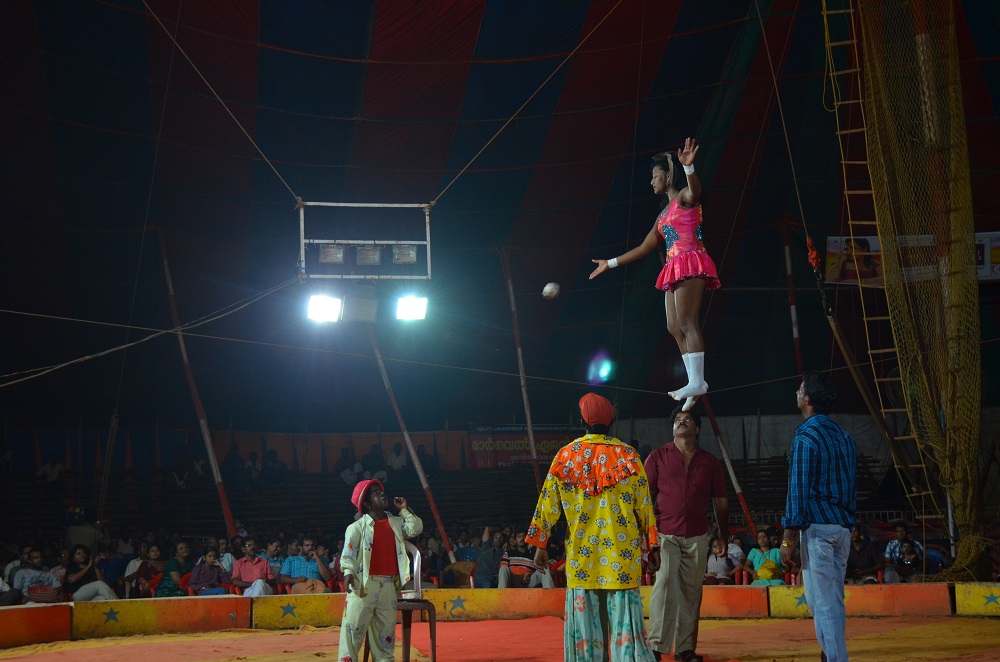The regulatory authorities and the industry are yet to reinvent the circus acts reeling from the wake of disrepute for using child labour and training animals in an unsuitable environment.
The first organised circus originated in a small princely state of Kuruvadan in Maharashtra as a result of the heroic deed of VP Chatre, a horse trainer of the king. This was in 1880. Initially Chatre’s wife and disciples were the only partners and it was named The Great Indian Circus. The Circus blossomed, flourished and gained fame throughout the 20th century. Many other circus companies also emerged and became popular during this period. Today, however, the circus industry is undergoing a great crisis, which they have never witnessed in the history of Indian circus.
The Grand India Circus shows were dominated by animal circus acts, and lacked human performances in the initial years. They became the target of human right activists and animal right workers, and organisations who were fighting against employing child labour. Although the official Indian Circus was founded in 1880, the public performance of juggling, acrobatics and animal training were a part of Indian street shows for many years. These circus acts were performed primarily at festivals, celebrations and mega feasts. In several towns and villages, these shows still garner a large audience.
The influence of these acts brought about a considerable change in the character of modern circus in India. In arenas too large for speech to be easily audible, the traditional comic dialogues of the clowns assumed a less prominent place than it did earlier. The vastly increased wealth of stage properties relegated to the background of the old-fashioned equestrian feats. These were replaced by more ambitious acrobatic performances and by exhibitions of skill, strength and dare, requiring the employment of a large number of performers and often requiring complicated and expensive machinery.
Circus and child labour
In 1900s, more than 50 circus companies were performing throughout India. Today only about 10 circus companies are active in the field because they do not have alternative employment options. Indian circus lacks innovation and features many of the same circus acts it showcased decades ago. Several challenging situations such as poor financial position, natural disasters, procuring performance licenses and stricter animal regulations in the 21st century are partly to blame for these repetitive circus acts.
The Indian circus has been accused of using child labour in their performance acts. Often the employees, especially minor and under aged workers weren’t paid fair wages due to poor revenues from the shows.
In the face of failing business, circus companies have shifted their base from cities to semi-urban areas in a desperate bid to make both ends meet. Circus tents across India from Kerala to U.P have been raided on tip-offs of alleged child trafficking. Of course the authorities have seldom been proved wrong.
Circus No More a Wonder
Yes it’s true, the circus always leaves the audience speechless. However, the stories of hardship that emerge from behind the scenes of the circus tents could also leave the audience speechless for different reasons altogether. The stories of child trafficking, lack of wages, low quality of living have continuously plagued the circus industry in India. There are some silver linings too if you care to take a closer look. For instance, I have also met people with criminal backgrounds who have found a way to reform themselves working inside the circus tents. Some have transformed themselves by receiving daily ovations and claps from thousands of circus audiences.
Presently they are well settled with families in their circus tents and have been training the young circus artistes as a way to continue their art form. For them, circus is also a good rehabilitation space as they practice the circus acts, take risks while performing acrobatics show after show.
The most attractive feature of any Indian circus was the feats performed by the animals such as lion, tiger, elephants, rhinoceros, among others. These days the animals are out of circus camps due to the strict governmental regulations. Moreover, many of the open maidans earlier used for circus shows were suddenly being used to construct malls or sport stadiums or avenues for multi-storied complexes. Should the government on their part have banned all these at one stroke? Could they have handled the industry differently? Could they have helped the industry find alternatives and implemented them keeping in mind that circus is an art form?
Sorry state of affairs
It is ironic that even today circus is not considered an art form but included in the list of sports and games. Owing to this, no financial help is being provided to the circus from the Department of Culture. The only concession the industry receives is from the railways for their travels. In spite of such adverse circumstances, the circus is still surviving miraculously just like the wonder tricks performed by the artists in a show.
Even the tents, the costumes and the carpets of Indian circus do not appear fresh and colourful as they lack funds for maintenance and purchase inventory. They are unable to show their pomp, pleasure and splendour. When we see malnourished circus artistes, we are reminded of the lost lustre and glamour they once enjoyed. Their ‘T’shirts and trousers are torn and colour faded out. Those props they used earlier were attractive and colourful and have now become dull. Even the sounds and rhythms flown from the band sounds all 1970s — old and repetitive. Yes, it is true, the circus today is no art, no feat and therefore it is not a wonder in the eyes of the audience today.
Click here to read the previous parts
Write to us at editor@indiaartreview.com

